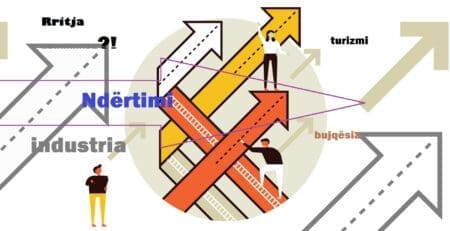Primary balance, credit rating agencies and long-term sustainability
According to the definition presented by the OECD[1] for the government’s primary balance, the most appropriate explanation is that “The primary balance is the difference between the amount of revenue a government collects and the amount it spends on providing public goods and services. A country has a primary deficit if it spends more on public goods and services than it collects in taxes. This means that the government has to borrow money to pay for the everyday public goods and services it provides to citizens, which may not be sustainable. The primary balance is thus a critical indicator of the short-term sustainability of a government’s finances.”
In the time frame 2013 – 2023, the primary balance of the Albanian state budget was positive (primary surplus) in at least half of the decade. Specifically, from 2016 – 2018 and from 2022 – 2023, the primary balance of the state budget was positive (see the table below).
| Primary balance | 6m.I 2013 | 6m.I 2014 | 6m.I 2015 | 6m.I 2016 | 6m.I 2017 | 6m.I 2018 | 6m.I 2019 | 6m.I 2020 | 6m.I 2021 | 6m.I 2022 | 6m.I 2023 |
| Deficit/ Surplus (m. Lek) | -48.584 | -22.195 | -12.464 | 17.251 | 2.690 | 2.314 | -2.506 | -38.686 | -29.142 | 15.200 | 46.157 |
The primary balance from 2024 is mandatory, according to the amendment to the Organic Budget Law (OBL), where it is determined that for each subsequent year the actual primary balance cannot be negative, so it must be either balanced or positive.
According to the fiscal indicators summarized in the table, there is a strong connection between the ratio for the first 6 months to the annual realization of income and expenses. In the years, where the primary balance is positive (2016-2018 and 2022-2023), there is a level of budget income close to half of the annual realization (1-2% less) and an expenditure realization with at least 5 to 9% less than their annual realization. Meanwhile, in the years when the primary balance is negative (primary deficit) it can be seen that:
- For the years 2013 – 2015, the level of budget revenue collection is close to half of the annual realization (2% less), but the expenses are either over half of the annual expenses in 2013, or up to 5% less than the annual realization of the expenses. . In these years, the difference between income and expenses is narrow with up to 3% more income. But, starting from the fact that the expenses are planned with at least over 3% annual deficit, then the narrow difference has an impact on the creation of the budget deficit, since it cannot be covered by the income.
- For the years 2019 – 2021, the level of budget revenue expenditure is 1 to 4% less. Expenses are up to 6% less than annual expenses. In these years, the difference between income and expenses is narrow with up to 2% more income. This narrow difference gives an effect in the creation of the budget deficit, as expressed in the table above.
| Budget performance | 2013 | 2014 | 2015 | 2016 | 2017 | 2018 | 2019 | 2020 | 2021 | 2022 | 2023 |
| Revenues 6m.I/Year | 48% | 48% | 48% | 49% | 49% | 48% | 49% | 46% | 46% | 49% | 50% |
| Expenditures 6m.I/Year | 52% | 45% | 45% | 42% | 45% | 45% | 46% | 44% | 44% | 41% | 41% |
In order to clarify and identify the impact on the primary balance, we have analyzed the impact of the implementation of budget expenditure items.
From the analysis of other expenditures of the state budget[2], which for the first 6 months of the last decade were spent up to the programmed part (with very few exceptions for transfers), then the expenditure that affected the result of in the primary balance of the budget, the item of investment expenses has been identified it.
The table below presents the values of public investments spent in the first 6 months of the last decade in relation to the annual investment’s expenditures.
| % of budget spent | 6m.I 2013 | 6m.I 2014 | 6m.I 2015 | 6m.I 2016 | 6m.I 2017 | 6m.I 2018 | 6m.I 2019 | 6m.I 2020 | 6m.I 2021 | 6m.I 2022 | 6m.I 2023 |
| Investments/Year | 63% | 33% | 33% | 28% | 39% | 39% | 39% | 33% | 36% | 27% | 26% |
In most years, their level of expenditures is as much as 1/3 of the annual expenditures. In the last two years (2022-2023), the investment’s expenditures in the first 6 months is at the levels of 26-27% of the annual investment’s expenditures.
In a connection of their spending in the years of positive primary balance, it can be seen that:
- In the years 2016-2018, the expenditures of investments for the first 6 months is respectively as much as 28% for the year 2016 and as much as 39% for the years 2017-2018. The primary positive balance is also in the same value trend. Where public investments have been spent less, it turns out that there is a higher difference in the value of the primary balance. While in the following two years, where investments were made by 11% more than in 2016, the positive primary balance is much smaller.
- In the years 2022 – 2023, the investment’s expenditures for the first 6 months is respectively as much as 27% for the year 2022 and as much as 26% for the year 2023. In the same trend, the value of the positive primary balance has also increased.
- In the years 2013-2015, the investment’s expenditures in the first 6 months of 2013 is as much as 63% of the annual investments and in the following two years, the investment’s expenditures is as much as 33% of the annual investment’s expenditures. In these years, the primary balance is negative, where the low collection of revenues for the first 6 months also has an impact..
- In the years 2019 – 2021, the same arguments apply, which according to the table show the same trends of investment values, but also of the income received, affecting the primary negative balance.
In conditions where the weight of public investments has a very large impact on the primary balance, but especially on the general balance of the state budget, it can be seen that the non-realization of the public investment budget program gives a positive impact on maintaining the low level of annual budget deficit.
So, in other words, a weak financial management and administration, in this case it is an influence that through maintaining the low level of the deficit (a typical case is the year 2023, where revenues increased for objective and subjective reasons, while expenses were realized more less than the budget law), the level of public debt is also affected, which this year decreased to a very optimistic level even for the government’s own forecasts.
A lower level of public debt, together with some stronger regulatory measures, which have an impact on the assessment of the financial health of the government budget by credit rating agencies[3], affect an assessment for the country. But, this has little value, as long as this evaluation does not go deeper into the analysis of the impact and factors that give role to public finance indicators.
Beyond the work done by the Ministry of Finance to strengthen public finances through chain measures for income and expenditure, it can be seen that the connection of the primary balance is worth the government in order not to face much higher borrowing costs[4], but not that it makes a visible difference in strengthening the country’s economic positions and in the eyes of foreign investors, since that alone is not enough.
Although (a) macroeconomic indicators have improved but not significantly, (b) unemployment is at historical lows, but among young people it is among the highest, (c) inflation has returned to the target ahead of expectations, but with growth in daily products, (d) the external position has improved thanks to the very good performance of the tourism sector, but with strong problems influenced by informality and the unstructured economy, (e) foreign direct investments have reached the highest historical levels , but 1/3 of them are from the offshore area and in terms of real estate, (f) budget revenues have increased, but with a high cost of corruption and informal money that is limiting the growth and development of businesses, then in summary , this development is very uncertain, lacking confidence in its sustainability, and is being carried out in conditions where economic freedom is continuously limited by government decisions.
In fact, the best way, beyond the government’s tendency to show a more optimistic reality of the public finance situation of the indicators as above, is the coordinated orientation of economic reforms in the influence of a qualitative and diversified growth above current levels.
Currently, most of the growth comes from unstable sectoral developments[5] that cannot guarantee the objectives for sustainable development of the economy.
Despite the very large investments for the budget possibilities, with the acceptable argument to close the gaps of the inherited infrastructure, it is found that Albania is still not well integrated with the global value chains[6]. “Albania’s connections[7] are among the weakest in the Western Balkans, mainly due to the high concentration of exports in the production of low-value products, raw goods and tourism. The IMF’s analysis shows that by improving infrastructure, labor skills and the adoption of trade policies that ensure investor protection and harmonize regulations and legal provisions, it can greatly increase Albania’s engagement with the external market”.
These are tangible arguments, where despite the wish to receive the best international evaluations for the country, it seems that this is all that has been done to date and the lack of openness of governance to transparency and accountability cannot strengthen Albania’s external positions and bring concrete benefits to the country’s economy, at least for a future period of several years.
[1] https://www.oecd-ilibrary.org/sites/42c624f3-en/index.html?itemId=/content/component/42c624f3-en
[2] Expenses for salaries and insurance, expenses for debt payment, expenses for social security and social protection and expenses for local government, etc.
[3] Moody’s, Standard & Poor’s, Fitch
[4] a one percentage point increase in the primary deficit is associated with an increase in the unit cost of debt service of over 20 basis points
[5] Energy is affected by the weather, construction by tolerating anti-evasionist policies, tourism can be neutralized by the lack of physical, but also skilled, labor force.
[6] So, how well is the economy connected to the external market for its products
[7] https://www.imf.org/-/media/Files/Publications/DP/2019/English/LGWBEA.ashx




Leave a Reply
You must be logged in to post a comment.